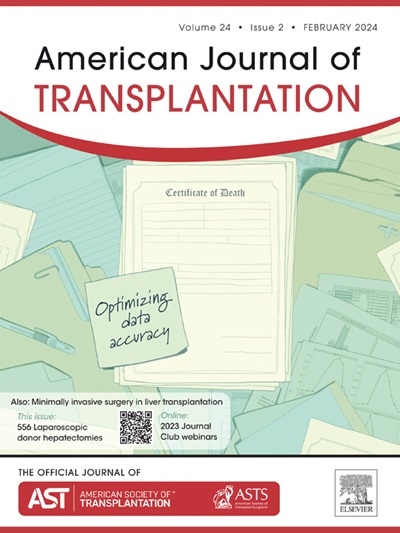Evolving Landscape of Thrombotic Microangiopathy in Kidney Transplant Recipients in the post C5 inhibitor Era.
IF 8.2
2区 医学
Q1 SURGERY
引用次数: 0
Abstract
A comprehensive analysis was performed on all consecutive biopsy-proven Thrombotic Microangiopathy (TMA) complicating kidney transplantation in the post C5 inhibitor era (from 2009) to identify pathological profiles, determine causes and establish risk factor associated with death-censored graft survival, in two French center. Pathological criteria were assessed according to the TMA Banff Working Group, followed by an unbiased analysis to identify distinct subgroups. 119 cases were identified, 8(6.7%) primary TMA, and 23(19.3%) antibody-mediated rejection. In 98 cases (82.4%), more than one potential trigger was involved. Latent class analysis identified two groups: acute TMA pattern (n= 79(66.4%)) enriched for fibrin thrombi in glomerular capillaries and arterioles and mesangiolysis, and chronic active TMA pattern (n= 40 (33.6%)) enriched for collapsed capillaries. Both had similar presentation, were not indicative of specific causes but had different outcome. In multivariate analysis, grade 3 hypertension, low hemoglobin levels, proteinuria, baseline serum creatinine and the value of a Banff-based chronicity index (ct + ci + 2xcg +cv) were associated with poorer death-censored graft survival, while fibrin thrombi in glomerular capillaries were associated with a better outcome. KT-TMA is a severe condition in which the pathological pattern may reflect the disease stage, rather than the often intricate underlying mechanism.后C5抑制剂时代肾移植受者血栓性微血管病变的演变景观
在两个法国中心,对后C5抑制剂时代(自2009年起)所有连续活检证实的血栓性微血管病(TMA)并发肾移植进行了全面分析,以确定病理特征,确定原因并确定与死亡审查的移植物存活相关的危险因素。根据TMA Banff工作组评估病理标准,然后进行无偏分析以确定不同的亚组。其中原发性TMA 8例(6.7%),抗体介导的排斥反应23例(19.3%)。在98例(82.4%)中,涉及一个以上的潜在触发因素。潜在分类分析确定了两组:急性TMA模式(n= 79(66.4%))和慢性活动性TMA模式(n= 40(33.6%)),前者富集于肾小球毛细血管和小动脉的纤维蛋白血栓和脉管溶解,后者富集于毛细血管崩溃。两者都有相似的表现,不表明具体的原因,但结果不同。在多变量分析中,3级高血压、低血红蛋白水平、蛋白尿、基线血清肌酐和基于banff的慢性指数(ct + ci + 2xcg +cv)的值与较差的死亡-剔除移植存活相关,而肾小球毛细血管中的纤维蛋白血栓与较好的预后相关。KT-TMA是一种严重的疾病,其病理模式可能反映疾病阶段,而不是通常复杂的潜在机制。
本文章由计算机程序翻译,如有差异,请以英文原文为准。
求助全文
约1分钟内获得全文
求助全文
来源期刊
CiteScore
18.70
自引率
4.50%
发文量
346
审稿时长
26 days
期刊介绍:
The American Journal of Transplantation is a leading journal in the field of transplantation. It serves as a forum for debate and reassessment, an agent of change, and a major platform for promoting understanding, improving results, and advancing science. Published monthly, it provides an essential resource for researchers and clinicians worldwide.
The journal publishes original articles, case reports, invited reviews, letters to the editor, critical reviews, news features, consensus documents, and guidelines over 12 issues a year. It covers all major subject areas in transplantation, including thoracic (heart, lung), abdominal (kidney, liver, pancreas, islets), tissue and stem cell transplantation, organ and tissue donation and preservation, tissue injury, repair, inflammation, and aging, histocompatibility, drugs and pharmacology, graft survival, and prevention of graft dysfunction and failure. It also explores ethical and social issues in the field.

 求助内容:
求助内容: 应助结果提醒方式:
应助结果提醒方式:


